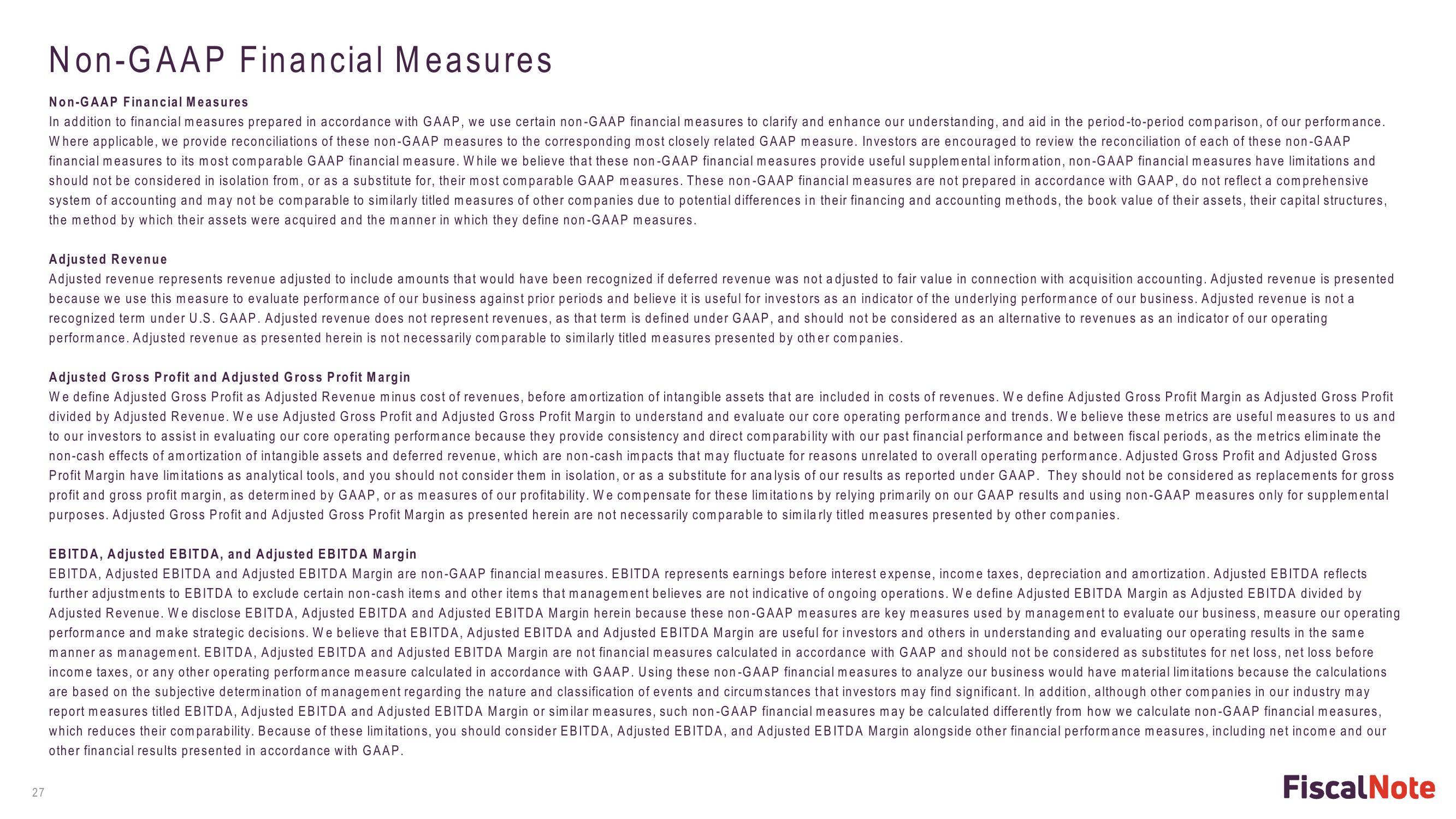FiscalNote Investor Presentation Deck
27
Non-GAAP Financial Measures
Non-GAAP Financial Measures
In addition to financial measures prepared in accordance with GAAP, we use certain non-GAAP financial measures to clarify and enhance our understanding, and aid in the period-to-period comparison, of our performance.
Where applicable, we provide reconciliations of these non-GAAP measures to the corresponding most closely related GAAP measure. Investors are encouraged to review the reconciliation of each of these non-GAAP
financial measures to its most comparable GAAP financial measure. While we believe that these non-GAAP financial measures provide useful supplemental information, non-GAAP financial measures have limitations and
should not be considered in isolation from, or as a substitute for, their most comparable GAAP measures. These non-GAAP financial measures are not prepared in accordance with GAAP, do not reflect a comprehensive
system of accounting and may not be comparable to similarly titled measures of other companies due to potential differences in their financing and accounting methods, the book value of their assets, their capital structures,
the method by which their assets were acquired and the manner in which they define non-GAAP measures.
Adjusted Revenue
Adjusted revenue represents revenue adjusted to include amounts that would have been recognized if deferred revenue was not adjusted to fair value in connection with acquisition accounting. Adjusted revenue is presented
because we use this measure to evaluate performance of our business against prior periods and believe it is useful for investors as an indicator of the underlying performance of our business. Adjusted revenue is not a
recognized term under U.S. GAAP. Adjusted revenue does not represent revenues, as that term is defined under GAAP, and should not be considered as an alternative to revenues as an indicator of our operating
performance. Adjusted revenue as presented herein is not necessarily comparable to similarly titled measures presented by other companies.
Adjusted Gross Profit and Adjusted Gross Profit Margin
We define Adjusted Gross Profit as Adjusted Revenue minus cost of revenues, before amortization of intangible assets that are included in costs of revenues. We define Adjusted Gross Profit Margin as Adjusted Gross Profit
divided by Adjusted Revenue. We use Adjusted Gross Profit and Adjusted Gross Profit Margin to understand and evaluate our core operating performance and trends. We believe these metrics are useful measures to us and
to our investors to assist in evaluating our core operating performance because they provide consistency and direct comparability with our past financial performance and between fiscal periods, as the metrics eliminate the
non-cash effects of amortization of intangible assets and deferred revenue, which are non-cash impacts that may fluctuate for reasons unrelated to overall operating performance. Adjusted Gross Profit and Adjusted Gross
Profit Margin have limitations as analytical tools, and you should not consider them in isolation, or as a substitute for analysis of our results as reported under GAAP. They should not be considered as replacements for gross
profit and gross profit margin, as determined by GAAP, or as measures of our profitability. We compensate for these limitations by relying primarily on our GAAP results and using non-GAAP measures only for supplemental
purposes. Adjusted Gross Profit and Adjusted Gross Profit Margin as presented herein are not necessarily comparable to similarly titled measures presented by other companies.
EBITDA, Adjusted EBITDA, and Adjusted EBITDA Margin
EBITDA, Adjusted EBITDA and Adjusted EBITDA Margin are non-GAAP financial measures. EBITDA represents earnings before interest expense, income taxes, depreciation and amortization. Adjusted EBITDA reflects
further adjustments to EBITDA to exclude certain non-cash items and other items that management believes are not indicative of ongoing operations. We define Adjusted EBITDA Margin as Adjusted EBITDA divided by
Adjusted Revenue. We disclose EBITDA, Adjusted EBITDA and Adjusted EBITDA Margin herein because these non-GAAP measures are key measures used by management to evaluate our business, measure our operating
performance and make strategic decisions. We believe that EBITDA, Adjusted EBITDA and Adjusted EBITDA Margin are useful for investors and others in understanding and evaluating our operating results in the same
manner as management. EBITDA, Adjusted EBITDA and Adjusted EBITDA Margin are not financial measures calculated in accordance with GAAP and should not be considered as substitutes for net loss, net loss before
income taxes, or any other operating performance measure calculated in accordance with GAAP. Using these non-GAAP financial measures to analyze our business would have material limitations because the calculations
are based on the subjective determination of management regarding the nature and classification of events and circumstances that investors may find significant. In addition, although other companies in our industry may
report measures titled EBITDA, Adjusted EBITDA and Adjusted EBITDA Margin or similar measures, such non-GAAP financial measures may be calculated differently from how we calculate non-GAAP financial measures,
which reduces their comparability. Because of these limitations, you should consider EBITDA, Adjusted EBITDA, and Adjusted EBITDA Margin alongside other financial performance measures, including net income and our
other financial results presented in accordance with GAAP.
FiscalNoteView entire presentation